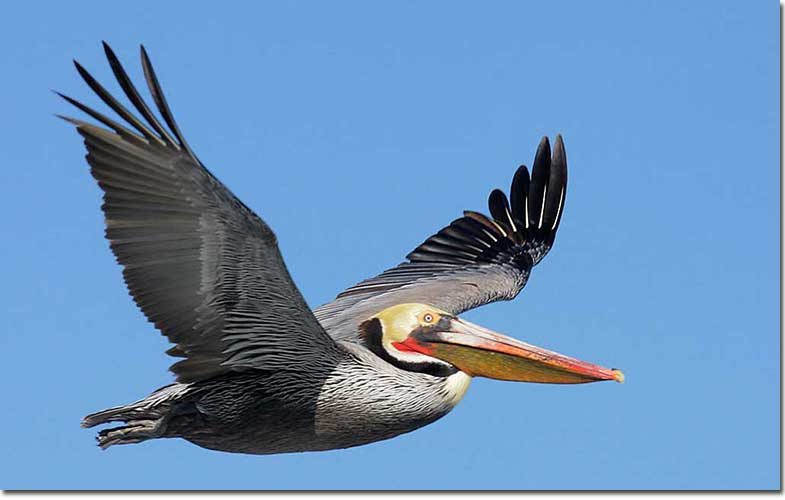
Louisiana is a mid-sized, deep southern state with 52,378 square miles of wetlands, subtropical woodlands, pine forests, and other habitats. More than 4,657,00 people live in Louisiana along with a lot of birds; 489 bird species have been found in The Pelican State!
Louisiana, known as “The Pelican State,” prominently features the brown pelican as its official state bird. This majestic bird is not only depicted on Louisiana’s state flag and state seal but also takes a central place in the state painting, alongside various other symbols and icons representing Louisiana’s rich heritage.
Additionally, the brown pelican is one of three Louisiana symbols proudly showcased on the U.S. Mint’s bicentennial quarter.
On this page
Louisiana State Bird
The Brown Pelican (pelecanus occidentalis ) became the state bird of Louisiana on July 27, 1966. The Louisiana legislature voted for this species to act as a symbol for Louisiana for a couple of reasons. In the 60s, populations of Brown Pelicans were in serious trouble.
Nowadays, this species is common in many coastal areas, but back then, it had become very rare. Along with raptors and other birds, during the 1950s, Brown Pelicans suffered from the effects of DDT poisoning.
By 1961, pelicans no longer nested in Louisiana and had become a rare sight in places where they used to be abundant.
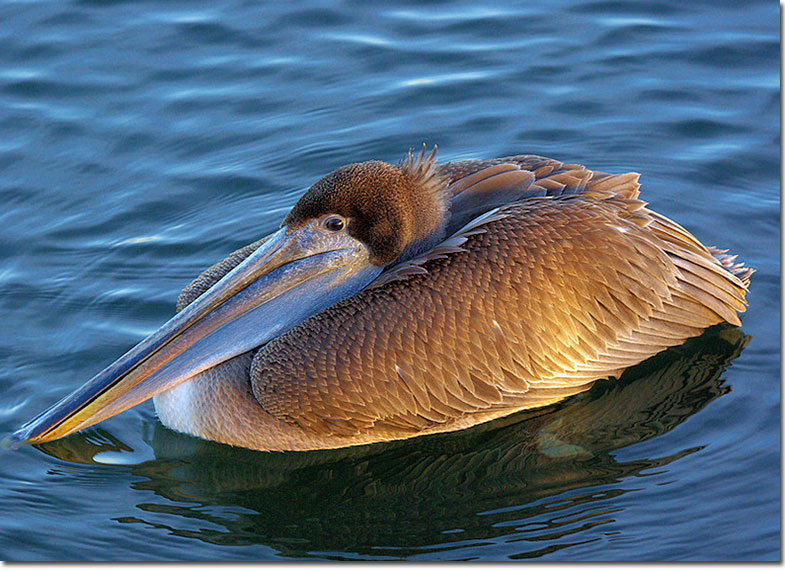
To show support for the Brown Pelican, in 1966, Louisiana decided to name the species their official state bird. At the same time, birds from Florida were reintroduced to the Louisiana coast. Shortly after, DDT was banned and since then, Brown Pelicans have once again become a common species in the state.
The Brown Pelican was also an easy choice for the state bird because pelicans have always played an important role in Louisiana culture. On account of the dedicated care pelicans give to their young, the first French settlers in the area held these birds in high regard.
This regard and admiration for pelicans has carried on into modern-day times and is why we find a pelican feeding its babies pictured on the Louisiana state flag.
Where can you find them?
Brown Pelicans live in pacific, Atlantic, and Gulf Coast coastal waters. We find them along beaches, in estuaries, near mangroves, and in other coastal habitats.
They breed along the coast of the Gulf of Mexico, and along the eastern seaboard north to Virginia. In the west, they also breed in coastal areas of southern California.
In 1961, the application of pesticides led to the cessation of pelican nesting along the Louisiana coast, ultimately resulting in their complete disappearance by 1966. To address this alarming decline, Louisiana initiated efforts to rejuvenate its coastline ecosystem by introducing fledgling pelicans from Florida into the state.
Non-breeding birds in United States range north to Washington State in the west and to New Jersey in the east. This species also breeds in the Caribbean, Mexico, and in Central America south to Ecuador, the Galapagos Islands, and the Guyanas.
The female lays between two and four eggs.
In many places, Brown Pelicans are common and obvious birds that fly over beaches and dive into waters just offshore. We also see them perched on pilings and boats, and some hope to be fed scraps of fish.
Nesting Brown Pelicans make shallow depressions on the ground or bulky stick nests in mangroves and other coastal trees. They usually nest in colonies adjacent to coastal waters.
Fun Facts about the Brown Pelican
- High divers. Brown Pelicans can dive headfirst, 60 feet above the surface of the water! After catching a fish, they float on the surface and hold their beak up to drain out excess water.
- Strict diving positions and protection. When the Brown Pelican plunge dives into the water, it tucks in its head and twists its body to the left. It probably does this to protect its throat and neck. They also have air sacs they inflate just before impact to protect their internal organs.
- One of the only coastal pelicans. Although there are eight species of pelicans, only two reside in coastal waters; the Brown Pelican, and the closely related Peruvian Pelican.
- Many names for pelican flocks. There are many terms for a group of pelicans including “brief”, “pod”, “squadron”, and “pouch”.
- Ancient birds. The general shape and features of pelicans have changed very little over the past 40 million years.
- Flies on cushioned air. Brown Pelicans often glide just above the surface of the water in a line. They do this to take advantage of air just above the water that helps them fly with very little effort.
- A pouch for three gallons of water. The bill pouch of this species can hold three gallons of water!
Identification
The Brown Pelican is an easy bird to recognize. In North America and much of its range, it is the only pelican species with dark plumage. Both sexes look alike, although males are a bit larger than females.
The average length of the Brown Pelican is 51 inches. They have a big, six-feet-plus wingspan and weigh around 8.2 pounds. In breeding plumage, these big birds are grey above, and are dark chocolate brown below.
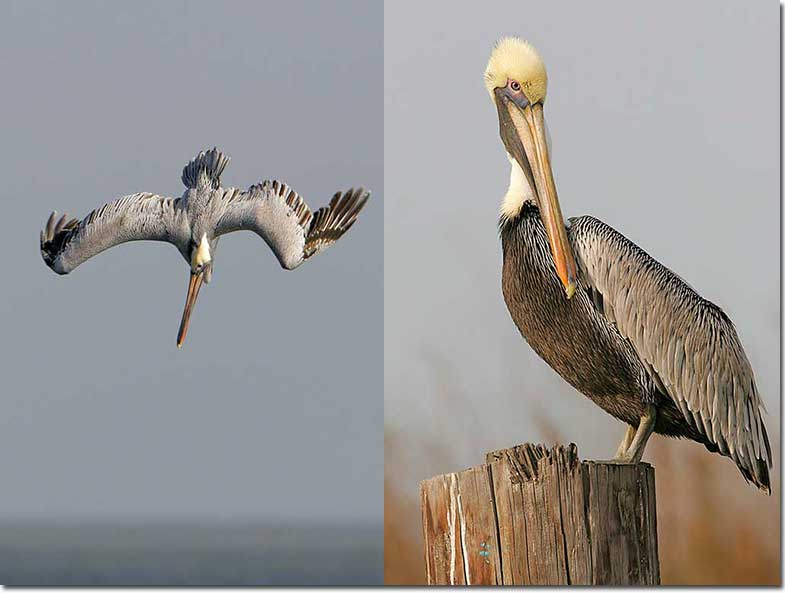
They have dark brown and white necks and breast with pale yellow on their heads, and have a long beak with a big dark brown pouch. On the west coast, they have a reddish pouch.
In the breeding season, its plumage undergoes a transformation, with the feathers on its head taking on a vibrant shade of yellow.
After breeding, Brown Pelicans have all-white necks, only a bit of yellow on their heads, and less colorful bills. For example, although western birds still have a bit of red on their beaks, their bill pouch takes on a dull grayish coloration. Juveniles are plain brownish-gray with a white belly.
What do Brown Pelicans eat?
Brown Pelicans have a diet that mostly consists of fish. Although they sometimes eat crustaceans and invertebrates, they usually catch and eat small and mid-sized fish.
They eat almost any fish they can catch but often feed on herring, pigfish, sheepshead, mullet, and grass minnows.
Although it will pick up scraps of fish and other food tossed to it, this species catches almost all of its food by plunge-diving into the ocean. To forage, Brown Pelicans fly above the water and watch for fish.
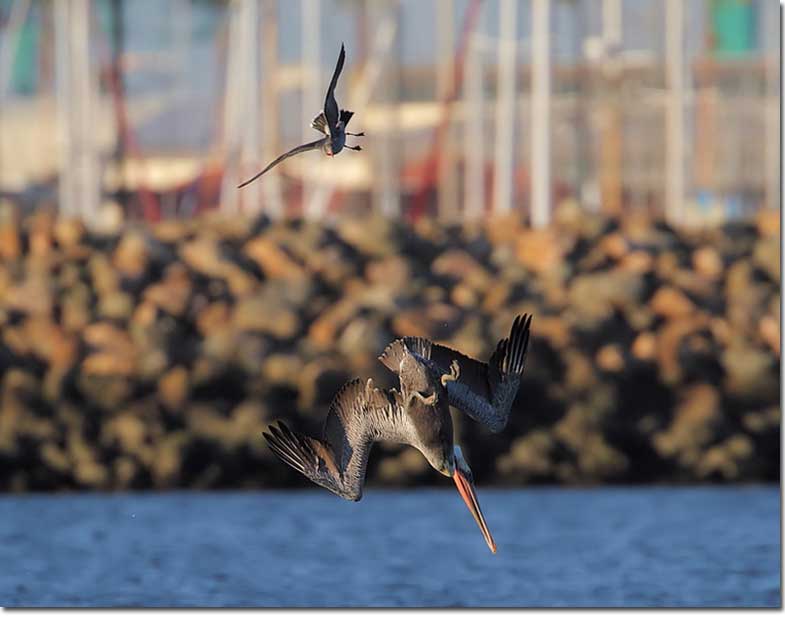
If they see a shoal of fish moving near the surface or fish being driven to the surface, they fold their wings and plunge straight down, headfirst into the water. Under the surface, they open their beak and hope to scoop up a fish or two.
After catching their prey, they float on the surface, hold their beak up to drain out the water, and position the fish to swallow it down, headfirst.
And yes, they love sardines and anchovies!
Vocalizations
Unlike most other birds, Brown Pelicans are usually silent. They rarely make any noise while foraging, flying, or floating on the water. The only vocalizations adults make seem to happen during courtship displays and even then they just make some low, gruff sounds.
Young birds make more noise, mostly when they are nestlings. They make squawking sounds while begging for food.
Behavior
The Brown Pelican spends most of its time flocking with other pelicans as they search for food. They fly low over water, float on the surface, and often perch on boats and piers.
When they notice schooling fish, the birds fly above and then plunge down to try and catch prey.
When not foraging, they tend to perch in coastal areas, including at their nesting colonies. These sites can be on barrier islands, coastal cliffs, or in mangrove forests.
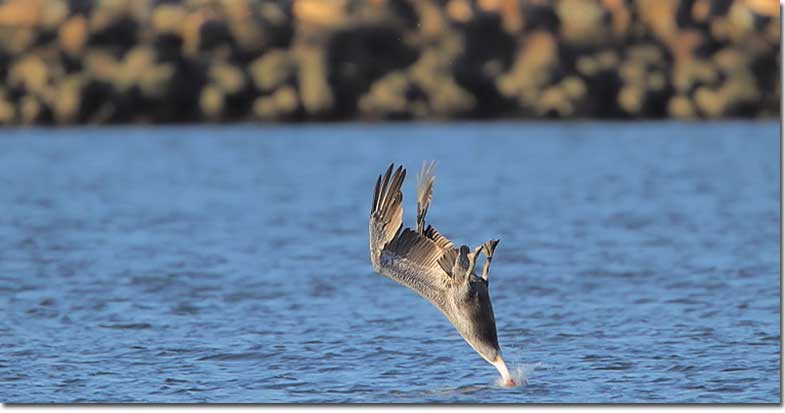
Despite its impressive size, this species does not pose any threat to people or their pets. Young and nesting birds are susceptible to Raccoons and some other predators but few animals prey on the adults.
However, while foraging and floating on the water, Brown Pelicans do have to be careful about sharks and Sea Lions. Both of these types of animals occasionally prey on the Brown Pelican.
Other Birds in Louisana
Northern Cardinal
The Northern Cardinal is a very common bird in Louisiana. It can be seen in gardens, forest edge, and shrubby habitats throughout the state.
Blue Jay
Blue Jays in Louisiana occur in woodlands, parks, and towns. These noisy birds usually move around in flocks.
Northern Mockingbird
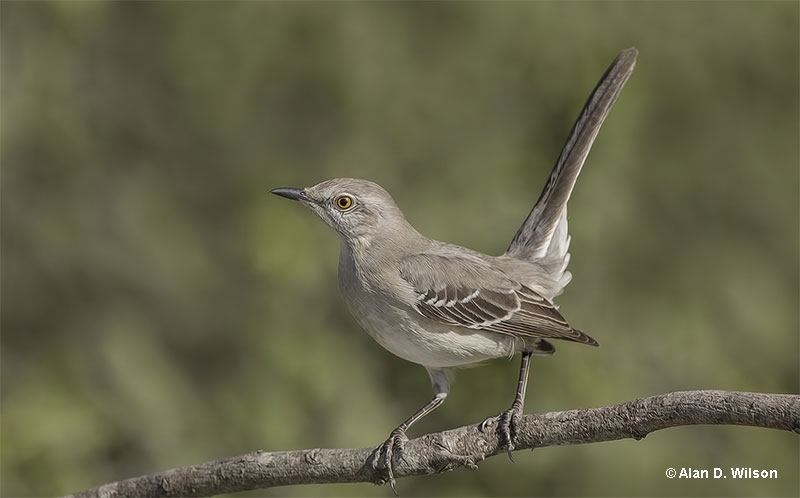
In Louisiana, the Northern Mockingbird lives in gardens, towns, parks, on golf courses, and just about any other semi-open habitat. They often sing from the tops of houses, trees, and telephone poles.
Carolina Wren
Carolina Wrens live in big gardens, parks, and woodlands. Its loud cheery song is heard throughout the state.
Carolina Chickadee
The Carolina Chickadee is the common chickadee of Louisiana. Small flocks frequent gardens, parks, and woodlands throughout the state.
American Crow
American Crows in Louisiana live in all sorts of habitats. We hear and see these noisy birds in towns, farmlands, and woodlands.
Mourning Dove
The Mourning Dove is the most common dove species in Louisiana. These pleasant birds frequent bird feeders, and live in gardens, parks, towns, farming areas, and woodlands.
Red-bellied Woodpecker
Red-bellied Woodpeckers live in parks, woodlands, and just about any other place with enough big trees. They also visit feeders and live in most urban areas.
Great Egret
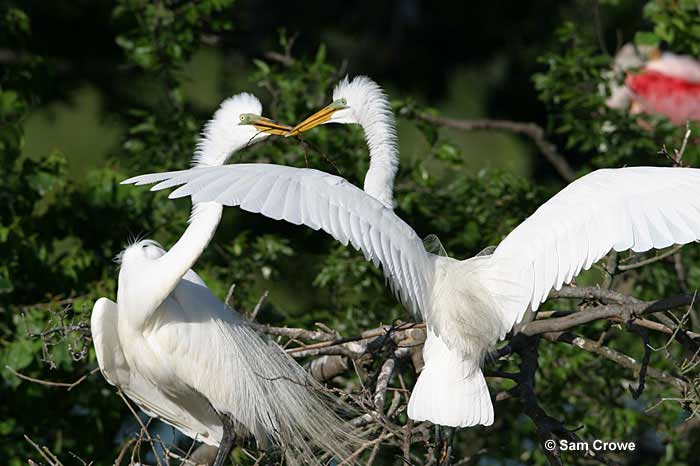
The Great Egret is a common wading bird of marshes, ponds, and most other wetlands. We can see them in ditches, at the edges of lakes in urban parks, and flying over most habitats in the state.
Downy Woodpecker
The Downy Woodpecker is a common species of parks and gardens. Most bird feeders have a regular pair that pays a visit. They also live in woodland habitats throughout the state.
Frequently Asked Questions
What is the state bird of Louisana?
The state bird of Louisana is the Brown Pelican. This impressive bird is often seen in coastal habitats.
Why is the Brown Pelican the state bird of Louisana?
The Brown Pelican is the state bird of Louisiana because it had disappeared from the state but was being reintroduced. Pelicans also play an important role in Louisiana culture.
When did Louisana choose its state bird?
Louisiana chose its state bird on July 27, 1966.
What other states have the Brown Pelican as their state bird?
No other state has the Brown Pelican as its state bird.
What was the previous state bird of Louisana?
There was no previous state bird for Louisiana.
Read next: Common birds in Louisiana | Hawks in Louisiana | Ducks in Louisiana

